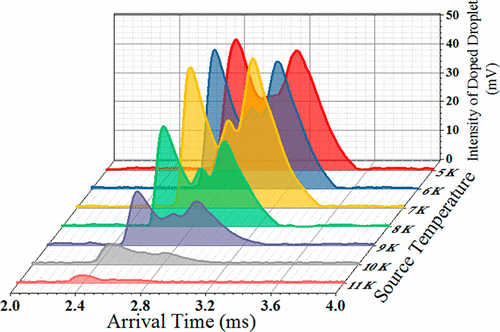当前位置:
X-MOL 学术
›
J. Phys. Chem. A
›
论文详情
Our official English website, www.x-mol.net, welcomes your feedback! (Note: you will need to create a separate account there.)
Doping of Green Fluorescent Protein into Superfluid Helium Droplets: Size and Velocity of Doped Droplets
The Journal of Physical Chemistry A ( IF 2.9 ) Pub Date : 2017-08-31 00:00:00 , DOI: 10.1021/acs.jpca.7b05718 Maha Alghamdi 1 , Jie Zhang 1 , Andrew Oswalt 1 , Joseph J. Porter 2 , Ryan A. Mehl 2 , Wei Kong 1
The Journal of Physical Chemistry A ( IF 2.9 ) Pub Date : 2017-08-31 00:00:00 , DOI: 10.1021/acs.jpca.7b05718 Maha Alghamdi 1 , Jie Zhang 1 , Andrew Oswalt 1 , Joseph J. Porter 2 , Ryan A. Mehl 2 , Wei Kong 1
Affiliation

|
We report doping of green fluorescent protein from an electrospray ionization (ESI) source into superfluid helium droplets. From analyses of the time profiles of the doped droplets, we identify two distinct groups of droplets. The faster group has a smaller average size, on the order of 106 helium atoms/droplet, and the slower group is much larger, by at least an order of magnitude. The relative populations of these two groups depend on the temperature of the droplet source: from 11 to 5 K, the signal intensity of the slower droplet group gradually increases, from near the detection limit to comparable to that of the faster group. We postulate that the smaller droplets are formed via condensation of gaseous helium upon expansion from the pulsed valve, while the larger droplets develop from fragmentation of ejected liquid helium. Our results on the size and velocity of the condensation peak at higher source temperatures (>7 K) agree with previous reports, but those at lower temperatures (<7 K) seem to be off. We attribute this discrepancy to the masking effect of the exceedingly large droplets from the fragmentation peak in previous measurements of droplet sizes. Within the temperature range of our investigation, although the expansion condition changes from subcritical to supercritical, there is no abrupt change in either the velocity distribution or the size distribution of the condensation peak, and the most salient effect is in the increasing intensity of the fragmentation peak. The absolute doping efficiency, as expressed by the ratio of ion-doped droplets over the total number of ions from the ESI source, is on the order of 10–4, while only hundreds of doped ions have been detected. Further improvements in the ESI source are key to extending the technology for future experiments. On the other hand, the separation of the two groups of droplets in velocity is beneficial for size selection of only the smaller droplets for future experiments of electron diffraction.
中文翻译:

将绿色荧光蛋白掺杂到超流氦滴中:掺杂滴的大小和速度
我们报告从电喷雾电离(ESI)来源的绿色荧光蛋白到超流氦滴的掺杂。通过分析掺杂液滴的时间分布,我们可以确定两组不同的液滴。速度更快的组的平均大小较小,约为10 6氦原子/液滴,而慢速基团则大得多,至少大了一个数量级。这两组的相对种群取决于液滴源的温度:从11到5 K,较慢的液滴组的信号强度逐渐增加,从接近检测极限到与较快的组相当。我们假设较小的液滴是通过脉冲阀膨胀时气态氦的冷凝而形成的,而较大的液滴则是由于喷射出的液态氦的碎裂而形成的。我们在较高源温度(> 7 K)下对凝结峰的大小和速度的结果与以前的报告一致,但在较低温度(<7 K)下的结果似乎不符。我们将这种差异归因于之前的液滴尺寸测量中来自碎裂峰的过大液滴的掩盖效果。在我们研究的温度范围内,尽管膨胀条件从亚临界变为超临界,但凝结峰的速度分布或大小分布都没有突然变化,最明显的作用是增加了碎片的强度顶峰。绝对掺杂效率约为10,约为离子掺杂液滴与ESI源离子总数之比。凝结峰的速度分布或大小分布都没有突然变化,最显着的作用是增加了破碎峰的强度。绝对掺杂效率约为10,约为离子掺杂液滴与ESI源离子总数之比。凝结峰的速度分布或大小分布都没有突然变化,最显着的作用是增加了破碎峰的强度。绝对掺杂效率约为10,约为离子掺杂液滴与ESI源离子总数之比。–4,而仅检测到数百个掺杂离子。ESI源的进一步改进是将该技术扩展到未来实验的关键。另一方面,将两组液滴的速度分开对于仅较小的液滴的尺寸选择是有益的,以用于将来的电子衍射实验。
更新日期:2017-09-04
中文翻译:

将绿色荧光蛋白掺杂到超流氦滴中:掺杂滴的大小和速度
我们报告从电喷雾电离(ESI)来源的绿色荧光蛋白到超流氦滴的掺杂。通过分析掺杂液滴的时间分布,我们可以确定两组不同的液滴。速度更快的组的平均大小较小,约为10 6氦原子/液滴,而慢速基团则大得多,至少大了一个数量级。这两组的相对种群取决于液滴源的温度:从11到5 K,较慢的液滴组的信号强度逐渐增加,从接近检测极限到与较快的组相当。我们假设较小的液滴是通过脉冲阀膨胀时气态氦的冷凝而形成的,而较大的液滴则是由于喷射出的液态氦的碎裂而形成的。我们在较高源温度(> 7 K)下对凝结峰的大小和速度的结果与以前的报告一致,但在较低温度(<7 K)下的结果似乎不符。我们将这种差异归因于之前的液滴尺寸测量中来自碎裂峰的过大液滴的掩盖效果。在我们研究的温度范围内,尽管膨胀条件从亚临界变为超临界,但凝结峰的速度分布或大小分布都没有突然变化,最明显的作用是增加了碎片的强度顶峰。绝对掺杂效率约为10,约为离子掺杂液滴与ESI源离子总数之比。凝结峰的速度分布或大小分布都没有突然变化,最显着的作用是增加了破碎峰的强度。绝对掺杂效率约为10,约为离子掺杂液滴与ESI源离子总数之比。凝结峰的速度分布或大小分布都没有突然变化,最显着的作用是增加了破碎峰的强度。绝对掺杂效率约为10,约为离子掺杂液滴与ESI源离子总数之比。–4,而仅检测到数百个掺杂离子。ESI源的进一步改进是将该技术扩展到未来实验的关键。另一方面,将两组液滴的速度分开对于仅较小的液滴的尺寸选择是有益的,以用于将来的电子衍射实验。



























 京公网安备 11010802027423号
京公网安备 11010802027423号